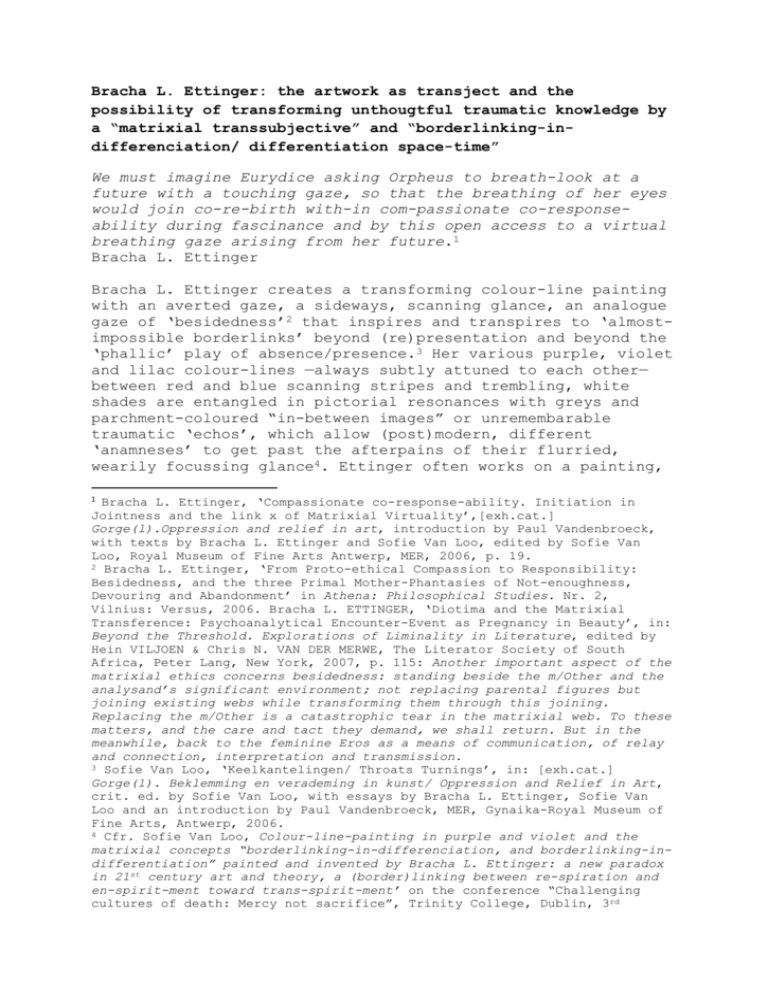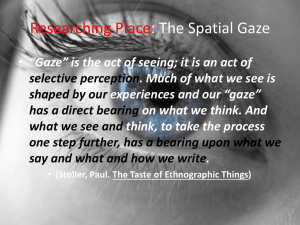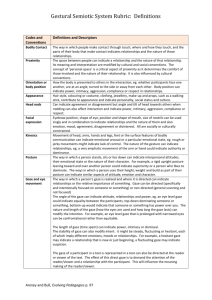
Bracha L. Ettinger: the artwork as transject and the
possibility of transforming unthougtful traumatic knowledge by
a “matrixial transsubjective” and “borderlinking-indifferenciation/ differentiation space-time”
We must imagine Eurydice asking Orpheus to breath-look at a
future with a touching gaze, so that the breathing of her eyes
would join co-re-birth with-in com-passionate co-responseability during fascinance and by this open access to a virtual
breathing gaze arising from her future.1
Bracha L. Ettinger
Bracha L. Ettinger creates a transforming colour-line painting
with an averted gaze, a sideways, scanning glance, an analogue
gaze of ‘besidedness’2 that inspires and transpires to ‘almostimpossible borderlinks’ beyond (re)presentation and beyond the
‘phallic’ play of absence/presence.3 Her various purple, violet
and lilac colour-lines —always subtly attuned to each other—
between red and blue scanning stripes and trembling, white
shades are entangled in pictorial resonances with greys and
parchment-coloured “in-between images” or unremembarable
traumatic ‘echos’, which allow (post)modern, different
‘anamneses’ to get past the afterpains of their flurried,
wearily focussing glance4. Ettinger often works on a painting,
1
Bracha L. Ettinger, ‘Compassionate co-response-ability. Initiation in
Jointness and the link x of Matrixial Virtuality’,[exh.cat.]
Gorge(l).Oppression and relief in art, introduction by Paul Vandenbroeck,
with texts by Bracha L. Ettinger and Sofie Van Loo, edited by Sofie Van
Loo, Royal Museum of Fine Arts Antwerp, MER, 2006, p. 19.
2 Bracha L. Ettinger, ‘From Proto-ethical Compassion to Responsibility:
Besidedness, and the three Primal Mother-Phantasies of Not-enoughness,
Devouring and Abandonment’ in Athena: Philosophical Studies. Nr. 2,
Vilnius: Versus, 2006. Bracha L. ETTINGER, ‘Diotima and the Matrixial
Transference: Psychoanalytical Encounter-Event as Pregnancy in Beauty’, in:
Beyond the Threshold. Explorations of Liminality in Literature, edited by
Hein VILJOEN & Chris N. VAN DER MERWE, The Literator Society of South
Africa, Peter Lang, New York, 2007, p. 115: Another important aspect of the
matrixial ethics concerns besidedness: standing beside the m/Other and the
analysand’s significant environment; not replacing parental figures but
joining existing webs while transforming them through this joining.
Replacing the m/Other is a catastrophic tear in the matrixial web. To these
matters, and the care and tact they demand, we shall return. But in the
meanwhile, back to the feminine Eros as a means of communication, of relay
and connection, interpretation and transmission.
3 Sofie Van Loo, ‘Keelkantelingen/ Throats Turnings’, in: [exh.cat.]
Gorge(l). Beklemming en verademing in kunst/ Oppression and Relief in Art,
crit. ed. by Sofie Van Loo, with essays by Bracha L. Ettinger, Sofie Van
Loo and an introduction by Paul Vandenbroeck, MER, Gynaika-Royal Museum of
Fine Arts, Antwerp, 2006.
4 Cfr. Sofie Van Loo, Colour-line-painting in purple and violet and the
matrixial concepts “borderlinking-in-differenciation, and borderlinking-indifferentiation” painted and invented by Bracha L. Ettinger: a new paradox
in 21st century art and theory, a (border)linking between re-spiration and
en-spirit-ment toward trans-spirit-ment’ on the conference “Challenging
cultures of death: Mercy not sacrifice”, Trinity College, Dublin, 3rd
in fact clusters/ constellations of different paintings for
years. Her paintings originate and “transform-in-jointness”.
What comes to a halt in one work, may continue in another
becoming artwork. Her paintings are constantly engaged in
silent conversations, both during the creative process and
when they are exhibited, i.e. in ever changing constellations.
The underlying in-between images appearing in some earlier
drawings and Eurydice-paintings, neither can be called
‘originals’, nor ‘photocopies’ of photographs (cfr. Brian
Massumi)5, are transported by and transforming within these
colour-lines in purples. What the artist ‘wit(h)nessed’6, which
is a matrixial concept, through ‘the silence’ of her parents
as a child7 has been attuned to particles and aerials of
different, other ‘wit(h)nessing’ psychocorporeal and
synaesthetic experiences, like for instance her own artistic
and psychoanalytic practice, which all is intensified within
this scanning desire of intensities touching and being touched
by other intensities that may be perceived in Ettingers lightbreathing purple, violet and lila colour-lines. In earlier
exhibitions like in her ‘installation’ at Le Nouveau Musée in
Vileurbanne (november 1992) Bracha L. Ettinger showed her
small archive of photographs: Ettinger’s mother Bluma Fried,
her father Uziel Lichtenberg walking in Lodz (Poland) with a
friend [who was later killed by the Nazis] (1937-8); her
mother Bluma Fried Lichtenberg working on a field in Slovakia
November 2007; Sofie Van Loo, Eros resonating between passion and “compassion” in some “borderlinking-in-differenciating borderlinking-indifferentiating” paintings by Titian and Bracha L. Ettinger: an artistic
dialogue between the 16th and the 20th/ 21st centuries, edited by Paul
Vandenbroeck, Annual Royal Museum of Fine Arts Antwerp (2006), pp. 163-215.
5 Brian Massumi, ‘Painting: The voice of the grain’, in: [exh.cat.] Bracha
Lichtenberg Ettinger. Artworking 1985-1999 (Borderline), Ludion, Palace of
Fine Arts, Brussels, 2000, p. 9: She uses the photocopier to interrupt the
line of descent between the original and its copy. The paper wrested from
the machine does not carry the original. Neither has it achieved a copy.
6
Bracha L. ETTINGER, ‘Wit(h)nessing Trauma and the Matrixial Gaze’, in:
Bracha L. Ettinger. The Matrixial Borderspace with foreword by Judith
Butler, Introduction by Griselda Pollock, edited and with afterword by
Brian Massumi, University of Minnesota Press, Minneapolis-London, 2006, p.
150: The matrixial gaze conducts imprints from “events without witnesses”
and passes them on to witnesses who were not there, whom I term
wit(h)nesses with-out events. The artist in the matrixial dimension is a
wit(h)ness with-out event in compassionate wit(h)nessing. The viewer, and
this partially includes the artist in his or her unconscious viewer
position, is the wit(h)ness with-out par excellence.
7 Griselda Pollock, ‘The graces of catastrophe: Matrixial time and
aesthetic space confront the archive of disaster’, in: Encounters in the
Virtual Feminist Museum. Time, space and the archive, Routledge, London-New
York, 2007, p. 174: To the face of this woman as later the artist’s mother,
Ettinger returns in the Eurydice series, searching it for the signs of
affective reciprocity the child needs in order to recognise its own human
configuration. Locked in an unrecognized mourning, her living suspension
between two dyings as the survivor, this mother ‘lives with the dead’.
Where must the child go to meet that mother?
(1941), Bluma Fried Lichtenberg and her two children8, an
almost-decapitated or at least ‘focusless’ Bracha L. Ettinger
with her daughter Lana, pregnancy echos and some other
photographs were exhibited parallel to her painting-drawings.
Some of these ‘family album’ images ‘echo’ in her paintings,
especially her series of Eurydice-paintings and her Matrix
Family Albums analogue to other, rather ‘anonymous’ images,
for instance a frieze of unclothed women and children seen
from the back in the Ukraine just before they will be shot by
the Nazis9, aerial views, maps of Palestine dating from before
WO II and fragments of texts in Hebrew, Latin or French,
references to concepts that are used in psychiatry and
psychoanalysis to diagnose patients. In some Eurydicepaintings finished at the end of 2006, these in-between images
have been disappeared and have been transformed in a colourline painting where they still may echo, although on an often
electrifying way or under layers of red. In her new serie
‘Ophelia’ Ettinger departs from selfportraits (as another
‘inbetween-image’), which are invisible on the level of the
painting, but lying underneath the layers of paint. The
transformation of ‘another’ trauma, the one of Palestine
“today” (for instance) can be experienced indirectly on a
“non-mapping” and beyond politics way through her work. Bracha
L. Ettinger works as a psychologist for the organization
‘Physicians for Human Rights’ in the Palestinian territories
and also this (psychoanalytic) practice enters her painting
art.
Bracha L. Ettinger ‘transforms’ trauma or at least particles
of trauma which can be connected on a transsubjective
(unconscious) level with particles of ‘jouissance’ by
connecting on a rather original way: she “borderlinks” and
makes “different” (cfr. ‘feminine’ sexual difference in the
Matrixial Gaze) on a level of ‘particles’ in stead of “a
wholeness/ a oneness” and this without focusing or
blindstaring on ‘details’ (cfr. Lacanian fascinum) and without
the distanced gaze of overviewing (google-)views, but with a
‘scanning-spiritual view’ of different, possible connecting
and becoming different intensities. By introducing resonating
and vibrating colour-lines Ettinger shifts from
(auto)biographic narrative (also: narcissicism and autism) AND
from social-political ‘mapping art’ and enters a
“transsubjective/ subsymbolic affective-non-cognitive spacetime, a matrixial space-time” which is rather ‘taboo’ in our
society and culture, but also in the artworld. It’s like ‘we’
are trained to ‘remember’ trauma, but can’t remember realized
and possible transforming and ‘healing’. In stead of
(re)presenting “the world” with a distanced/ focusing gaze or
8
9
Id., p. 174-176.
Id., P. 171.
(re)constructing “traumatic experience” (and by doing that
repeating it), Ettinger makes openings for transformation and
a giving-birth-and-becoming-in beauty. In the contemporary
artcontext often is created an ‘unheimlich/ uncanny’ scene or
an alienating athmosphere where the focus is on the
‘presentation’ and the ‘making present’ of the ‘unheimliche’.
Not ‘trauma’ can be called taboo in contemporary art (cfr.
contemporary ‘terms’ like apocalyptic art and anti-apocalyptic
art), but the possibility of ‘transforming particles of
trauma’ and the giving birth to a becoming-in-beauty and
touching by doing that ‘another’, non-romantic sublime.
In this seminar I especially will concentrate on what happens
on the level of Bracha L. Ettingers ‘colour-lines’ and what
these attunements may offer on the level of perception and
imagination, because colour and line, colorito and disegno
have mercy on each other in her art and this is a quite, rare
phenomenon in contemporary art. Ettinger paints from the
‘hiatus/ hiati’ (the consequences) of a phallic, binary
splitting “disegno” toward a matrixial colorito of colourlines, also with the suggestion of a possible, new phallic
gaze which doesn’t disconnect from the matrixial gaze. I will
analyse the artwork as “transject” in Ettinger’s colour-line
painting in terms of trauma, healing and transformation, and
offer the different meanings of her matrixial, borderspacing
concepts like ‘borderlinking-in-differenciation/
borderlinking-in-differentiation’ and ‘transsubjectivity’
(which is different than the ‘concept’ intersubjectivity) and
show some realized and virtual possibilities which can be
experienced and feel-thought from this ‘unfocussing point of
view’. The curatorial and artwriting practice of my PhDpromoter Prof.Dr. Paul Vandenbroeck and my own curatorial
practice are inspired by ‘the transpiriting and inspiriting’
matrixial artistic and theoretical practice of artist,
psychoanalyst Bracha L. Ettinger. Transformation (like
process, the performative etc.) can’t be called ‘taboo’ on a
conceptual-cognitive way at the level of the theoretical
discourse anymore, but like Bracha L. Ettinger has written
herself: The secret of Eros [the matrix] is not revealed in
the discourse but in the involvement in the erotic step
itself10. How comes that (the describing of/ or the
(re)presentation of ) the ‘erotic step’ can’t be called taboo
on a cognitive-non-affective level(anymore), but that this
‘involvement in the erotic step’ is/ stays rather taboo (or
difficult to take) on an affective-non-cognitive level in f.i.
our visual arts, in our contemporary societies/ cultures and
Bracha L. Ettinger, ‘Diotima and the Matrixial Transference:
Psychoanalytic Encounter-Event as Pregnancy in Beauty’, in: Beyond The
Threshold. Explorations of Liminality in Literature, edited by Hein Viljoen
& Chris N. Van der Merwe, The Literator Society of South Africa-Peter Lang,
New York, 2007, p. 129.
10
in our own lives? How ‘matrixial, transsubjective,
transpiriting and inspiriting co-response-ability’ can inspire
subjective, response-ability? How can the ‘artwork’ as
transject, an ‘object’ with transpirited and inspirited
aerials (transforming ‘abject’ and ‘transsubjective particles
of ‘trauma’ and ‘jouissance’), which can fascinate and touch
subjects (viewers, listeners etc.), not only play a role in
healing traumas (personal-interpersonal-transsubjective
traumas and memory), but trigger by doing that a particular
kind of (co-)responsibility of a ‘becoming-in-beauty’ and a
‘giving-birth-in-beauty’ without falling into nostalgia and
utopia, without falling into (superficial) narratives/
symbolisms or hierarchic/ rigid (over)views and distanced
discourses? If the matrix makes possible (feminine) sexual
difference (and sexual relation) for males and females (beyond
gender and biological thought “sex”) what could this mean
further for 21th century imagination and reality? Can we
‘play’ now more beyond (phallic) absence/ presence; does this
matrixial knowledge transforms the phallic plays of
absence/presence and denial/indifference? How the matrix and
the phallic could work together, if the discourse doesn’t deny
the matrix, neither ‘translates’ the matrix in terms of a
‘reconstruction/ restoration’, because over there already
important knowledge got “lost” again? How can we work with
this affective knowledge of the matrix in our private and
professional lives, research projects and relationships, if we
are not ‘professional artists’ or
‘psychoanalysts/psychologists’?
Sofie Van Loo








